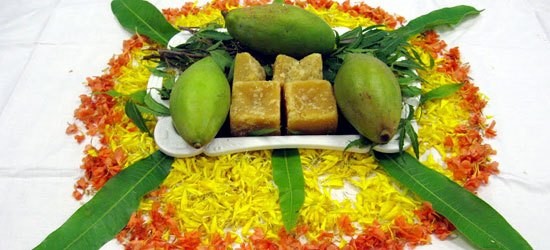Tamil New Year: Puthandu – Traditions and Rituals
Puthandu is the term for Tamil new year. It is the celebration of the first day of the Tamil new year. The new year celebration in India according to the Hindu calendars in different parts of the country usually takes place in the months of March-April. Puthandu, the people of Tamil Nadu celebrate their new year generally on April 14 according to the Gregorian calendar. It is also known by different names such as ‘Chithirai Tiru-Naal’ and ‘Varushap Pirappu’. The Tamil people welcome each other by exchanging words such as ‘Iniya Tamizh Puthandu Nalvaazhthukkal’ or simply ‘Puthandu Vazthukal’. It is also celebrated in Pondicherry and other places outside India like Sri Lanka, Singapore, Tamil populace in Malaysia, Reunion Island and Mauritius. It is also known as the yellow harvest festival of India.
Puthandu is the day of new beginnings. People celebrate the festival with joy. This day is celebrated with Neem leaves, flowers, and raw mangoes to symbolize growth and prosperity. The auspicious day of Puthandu is celebrated with all over Tamil Nadu. Tamil communities also observe Puthandu as the day when Lord Brahma started the creation of the Universe. Some also believe that Lord Indra, the ‘Prince of harmony’ visited earth on the day of Puthandu to certify contentment and amity. In Tamil Nadu, Puthandu is a day of feasting and merrymaking. Tamils celebrate this festival with hope and joy to ensure that the New Year brings growth and opportunities in their lives.
April 14 happens to be the beginning of the new year for most of the regions like Assam, West Bengal, Punjab, Manipur, Odisha etc. Hence, it is the time of celebration for almost half of India.
 Why only on April 14 ?
Why only on April 14 ?
Tamil New year always starts on April 14 and ends on April 13 the same as English New year starts on January 1st and ends on December 31. Chithirai 31 days, Vaigasi 31 days, Aani 32 days, Aadi 31 days, Aavani 31 days, Purattasi 31 days, Ippasi 30 days, Karthigai 29 days, Margazhi 30 days, Thai 29 days, Maasi 30 days, Panguni 30 days – Total days are 365 days.
The Tamil New Year follows the vernal equinox and generally falls on 14 April of the Gregorian year. 14 April marks the first day of the traditional Tamil calendar. The Tropical vernal equinox falls around 22 March, and adding 23 degrees of trepidation or oscillation provides the Hindu sidereal transition or Nirayana Mesha Sankranti (the solar transition into the constellation of Aries). The Tamil calendar thus begins on the same date observed by most traditional calendars in India as in Assam, West Bengal, Kerala, Manipur, Mithila, Odisha, Punjab, Tripura, Nepal, Bangladesh, Burma, Cambodia, Laos, Sri Lanka and Thailand. The 60-year cycle is ancient and is observed by most traditional calendars of India and China, and is related to 5 revolutions of Jupiter, or to the 60-year orbit of Nakshatras (stars) as described in the Surya Siddhanta.
The 60-year cycle comes by 5 revolutions of Jupiter and 2 revolutions of Saturn. The relative position of Jupiter and Saturn in one particular year will be repeated after 60 years. The 60-year cycle was essentially conceived for predicting the climate of a particular year, as the relative position of the two major planets, Jupiter and Saturn, is recognized for its impact on climate.
The traditional Tamil year starts on 14 April 2016 [Kali Yuga 5118]. The year may also be dated according to the Vikram Samvat or Saka era.
History
According to history, it is the day when Lord Indra also was known as the prince of harmony is believed to visit the earth to certify amity and contentment. He rides a chariot of white colour and wears a big crown made up of flowers on his head. He gets dipped into the ‘Kiri Sayura’ that means a sea of milk by breaking the gravity of the earth. It is also said that God of creation Lord Brahma starts his creation on this day.
There are several mentions in the literature of Tamil regarding this New Year that falls in April. In the 3rd Century, ‘Nakkirar’ who was the author of Nedunalvaadai wrote that from ‘Mesha Rashi’ Sun moves throughout eleven consecutive signs of Zodiac on this day. ‘Kudalur Kizhaar also mentioned this day as the starting of the year in Purannanooru. The ancient but still existing Tamil grammar known as ‘Tolkaapiyam’ separated the whole year into six different seasons in which this day is the beginning of summer season. Some other famous people such as ‘Silappadikaaram, and ‘Adiyarkunalaar’ also mentioned the same.
There are several references in early Tamil literature to the April new year. Nakkirar, Sangam period author of the Neṭunalvāṭai, wrote in the third century that the sun travels from Mesha/Chitterai through 11 successive signs of the zodiac.
 Kadalūr Kizhaar in the 3rd century refers to Mesha Raasi/Chitterai as the commencement of the year in the Puṟanāṉūṟu. The Tolkaapiyam is the oldest surviving Tamil grammar that divides the year into six seasons where Chitterai marks the start of the Ilavenil season or summer. The 8th-century Silappadikaaram mentions the 12 Raasis or zodiac signs starting with Mesha/Chitterai.
Kadalūr Kizhaar in the 3rd century refers to Mesha Raasi/Chitterai as the commencement of the year in the Puṟanāṉūṟu. The Tolkaapiyam is the oldest surviving Tamil grammar that divides the year into six seasons where Chitterai marks the start of the Ilavenil season or summer. The 8th-century Silappadikaaram mentions the 12 Raasis or zodiac signs starting with Mesha/Chitterai.
TheManimekalai alludes to the Hindu solar calendar as we know it today. Adiyarkunalaar, an early medieval commentator or Urai-asiriyar mentions the twelve months of the Tamil calendar with particular reference to Chitterai. There were subsequent inscriptional references in Pagan, Burma dated to the 11th century CE and in Sukhothai, Thailand dated to the 14th century CE.
 Ritual of Kanni
Ritual of Kanni
Tamil New Year According to the Tamil calendar, Puthandu is celebrated on the first day of the Chitterai month. People celebrate the festival with great joy and enthusiasm. On the eve of Puthandu, a tray is arranged with three fruits (mango, banana and jackfruit), betel leaves, areca nuts, gold/silver jewellery, money, flowers and a mirror. This tray has to be viewed early in the morning soon after waking up. This ritual is known as ‘Kanni,’ The ritual of ‘Kanni brings happiness and prosperity in the new year.
The entrance of the house is decorated with elaborate Kolams or rangoli. The middle of Kolam is decorated with ‘Kuhtuvillakku’ which symbolizes a lamp. People take an early morning bath and offer Pongal to Gods. People wear new clothes. They also visit temples to seek blessings of God. The young family members and children receive gifts or money from elders on Puthandu. The day of Puthandu is very auspicious to perform Brahman Bhoj. The head priest also reads out the ‘Panchangam.’ Several families also perform the ‘tharpanam’ rituals in remembrance of their ancestors on the day of Puthandu. A car festival is held on the occasion of Puthandu at Tiruvidaimarudur, near Kumbakonam. In Madurai, a huge exhibition known as the Chitterai Porutkaatchi is held at the Meenakshi Amman temple.
Must Read : The Hindu New Year – Different regions and different flavours of Celebration









